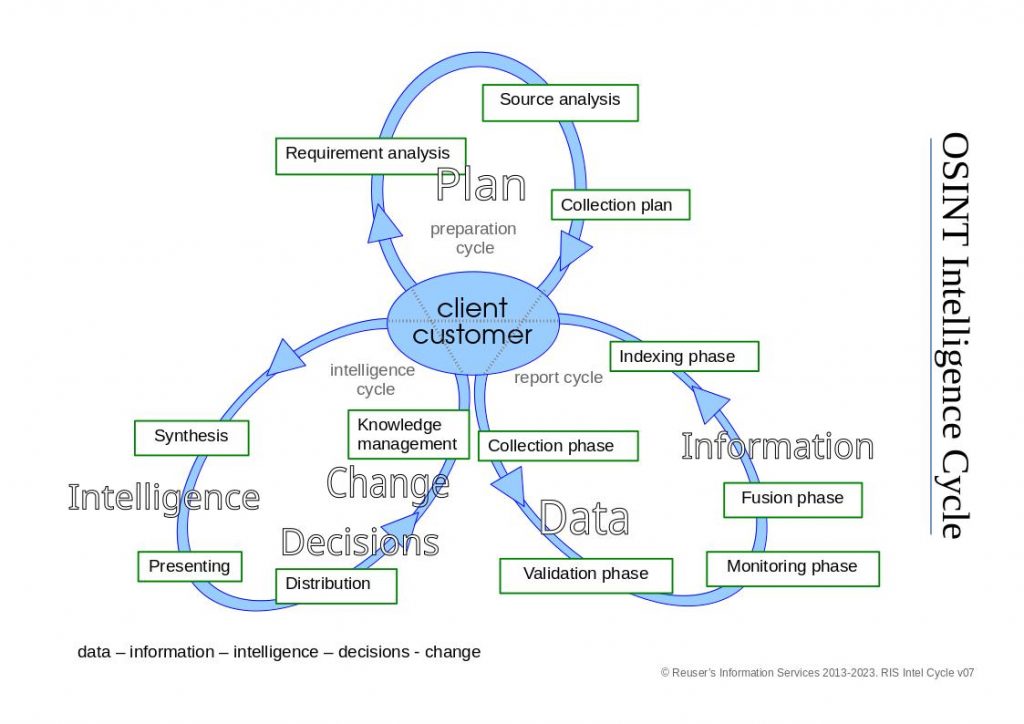While Google Guessing is by far the most popular universal search strategy used today, information professionals such as OSINTians, use well established search strategies to get the required information.
These strategies apply to almost every Internet search engine, commercial databases, any online database and even old fashioned (but sometimes unavoidable) card catalogues. It works beautifully in for instance Proquest Dialog retrieval systems, Delpher, Medline and many others.
Please note, search strategies are part of the OSINT search plan, which starts with requirement analysis and problem deconstruction, and finishes with the OSINT report. If there ever is a ”finish” that is. See the OSINT Intelligence Cycle. In addition, the approach in assigned indexing systems using controlled vocabularies is slightly different. But for the majority out there, the following three are a great help.

Building blocks
The first strategy is called Building Blocks and is part of the ‘systematic’ of the OSINT trias Systematic, Planned, Structured research. In Building Blocks, the OSINTian after the semantical analysis builds sets of equivalent terms, then makes a step by step cross section between the sets until the final result set.
For each step, check if Arno’s Law #2 applies: is there a match between the query and the result set. Building Blocks should usually return a fairly large set of results that are representative of what is available (recall) but in high volume and too low relevance.
Successive fractions
The next strategy would be successive fractions. The goal is to take the set from the previous step and gradually add factions to the query in order to bring down recall and bring up relevance. This continues until the recall has reached the desired level. I have changed this step a little by also adding modifiers to the query, although strictly speaking this is not successive fractions. Think about time, language, place, format etc.
For each step, the OSINTian carefully checks the result to see if recall goes down and relevance goes up. Additionally, to keep an eye out for new semantical variations. These will not be used now, but in the second round, so a note in the search log suffices.
At the end, the result will be a set of high relevance and low recall. It is now time to check the contents and do some bibliographic analysis.
Citation Pearl Growing
Originally only used to follow citations, this one too, is extended a little. Normally one uses citation pearl growing in conjunction with snowballing. That is, academic papers have references in the back that the OSINTian can follow to easily find more hopefully relevant material. The disadvantage is that the material gets older in time.
With citation pearl growing this is turned around. New material is retrieved by looking up which other authors have cited our starting paper, thus going up in time. That is the principle of the Science Citation Index, Google Scholar and many others.
Use both in conjunction to get quick and easy results without being dependent on keyword searching.
Therefore, while doing the successive fractions strategy, take note of author names, editors, coauthors, chairmen (conferences), journal titles etc that may be useful for citation pearl growing. Also off course semantics.
Conclusion
The above is not easy to use, but the learning curve is not very steep either. It just takes a change of mindset and a very structured approach to doing OSINT. And maintaining a OSINT logbook to keep track of your research and results. But if well executed, the above in conjunction with the other steps of the OSINT Intelligence Cycle will result in highly relevant open source information that meets the needs of the researcher, regardless the subject at hand and (almost) regardless the source used.
If you are interested in more information about these strategies, read Online searching : principles and practice / R.J. Hartely [et al.]. – London : Bowker Saur
Want to learn how to do this on moderns systems, the Internet and systems like that? Join me at the OSINT Pathfinder training programme https://opensourceintelligence.biz/pathfindertraining/
#OSINT #OSINTtraining #Intelligencetraining


